Introduction
Would you like to be able to pour your own crisp, refreshing lager at home? When I switched from making questionable hedgerow wine to brewing proper beer, I was surprised at how accessible it all felt. Thanks to the range of home brew lager kits UK shops now offer, getting started is easier than ever—even if you’ve never brewed before. In this beginner-friendly guide, I’ll talk you through some of the best kits on the market and what to expect, as well as sharing a few lessons I learned along the way.
In this beginner-friendly guide, I’ll talk you through some of the best lager kits on the market, what to expect during the brewing process and share some of the lessons I’ve learned the hard way.
What Makes Lager Different from Ale: Using a Lager Making Kit
Cold Fermentation & Clean Flavour
Lagers are brewed using bottom-fermenting yeast, which thrives in cooler temperatures ranging from 8 to 14°C. This slower, colder fermentation process gives lagers their clean, crisp flavour. Compared to ales, lagers tend to take longer to brew and require more patience (something I definitely had to work on early in my brewing journey). But the reward? A smooth, drinkable pint that rivals many commercial lagers. Using a lager making kit with a fermentation vessel designed for cooler temperatures is key to achieving the best results.
Why Lagers Are Popular Among UK Home Brewers
Let’s be honest — most of us grew up drinking lagers in the pub: Carling, Foster’s and Carlsberg, for example. They’re familiar, easy-drinking beers that appeal to nearly everyone. After experimenting with hoppier ales and juicy IPAs, I found myself wanting to recreate something crisp and crowd-pleasing that I could share with friends who weren’t hopheads. A well-made home lager does exactly that: it takes brewing back to basics, but still allows you to experiment and make adjustments.
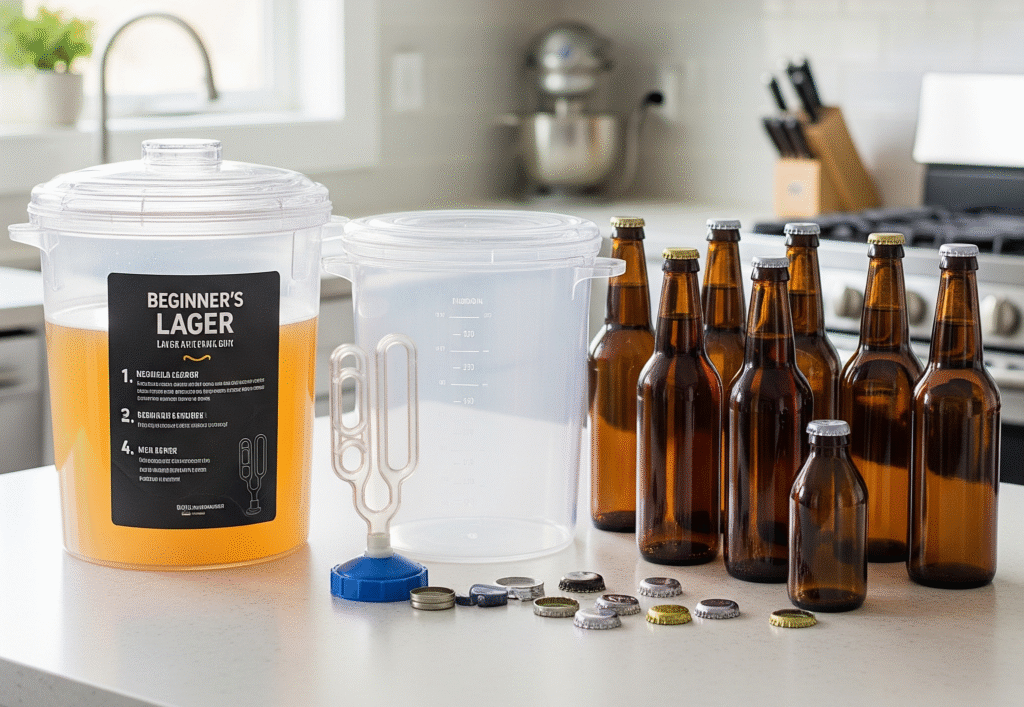
What to Look for in a Home Brew Lager Kit (UK Edition)
Yeast Type – Lager vs. Ale Yeast for Lager Kits
Some beginner-friendly kits include ale yeast instead of true lager yeast. Although it may sound like cheating, it’s actually very helpful if you’re brewing at room temperature and don’t have any specialised equipment. My first lager used ale yeast and fermented happily in the kitchen in spring — it turned out surprisingly clean and drinkable.
That said, once you’re ready to brew a true lager, you’ll need a kit containing actual lager yeast and a cooler space. I learnt this the hard way when excess foaming during a summer brew reminded me just how sensitive yeast is to temperature fluctuations.
Ingredient Quality
A good kit should include malt extract and hops (bonus points if it contains hop pellets or allows for dry hopping), as well as a yeast strain that is suited to the style of beer you want to brew. Having brewed with both cheap and premium kits, I can tell you that the difference is noticeable. One standout for me was a 10-pint Guinness-style kit. It exceeded my low expectations, offering deeper burnt notes and a better body than I anticipated. I knew I was onto something when even my neighbour, an experienced brewer, approved of it.
Equipment Requirements
Some kits contain just the ingredients, while others are full starter sets. If it’s your first time, go for a complete kit – it’ll save you from experiencing that last-minute panic of realising you don’t have a hydrometer! I tried demijohn brewing during my lager tests. I started out with just a demijohn and a funnel, and while that worked to an extent, having a proper fermentation vessel like a carboy makes the whole process much smoother and more enjoyable.
The Best Home Brew Lager Kits Available in the UK (2025 Review)
1. Muntons Premium Lager Kit
- Cons: Lacks depth of flavour compared to hopped kits
- Batch size: 40 pints (23L)
- Yeast: Ale yeast (ferments at room temperature)
- Skill level: Beginner
- Pros: Easy to use, affordable, great for first-time brewers
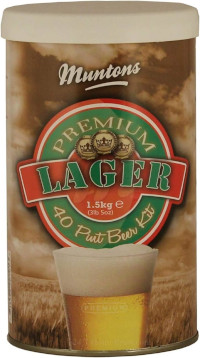
2. Festival New Zealand Pilsner Kit
- Batch size: 40 pints
- Yeast: Lager yeast (cooler fermentation recommended)
- Skill level: Beginner+
- Pros: Dry hops included, strong flavour profile, quality ingredients
- Cons: Slightly more complex process, requires cooler fermentation
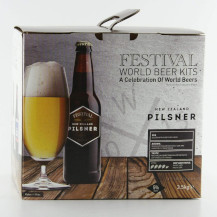
3. Coopers European Lager Kit
- Batch size: 23L
- Yeast: Lager yeast
- Skill level: Beginner+
- Pros: Clean, classic lager; great results when fermented cool
- Cons: May require temperature control during fermentation

4. Youngs Harvest Pilsner Lager
- Batch size: 40 pints
- Yeast: Lager yeast
- Skill level: Beginner
- Pros: Smooth, traditional European flavour; easy to brew, sugar included
- Cons: Label makes reading instructions tricky if you tear it badly
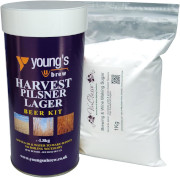
5. Muntons / Home Brew Online Lager Starter Kits
- Batch size: 23L
- Yeast: Varies (often ale yeast)
- Skill level: Total beginner
- Pros: Includes everything you need; excellent value for new brewers
- Cons: Higher upfront cost
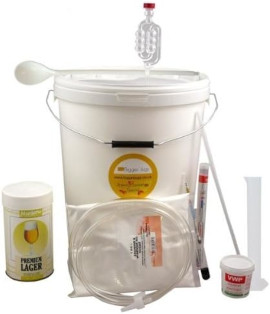
Tips for Brewing Better Lager at Home
Mind the Temperature
Temperature control is crucial for lagers. Initially, I had no idea why my fermenter would bubble vigorously one week and barely fizz the next. It turns out that yeast is picky! If you can’t afford a fermentation fridge, try brewing in the garage during winter, or put your fermenter in an insulated box to stabilise the temperature.
While lager kits often require more precise temperature control, cider fermentation is more flexible, making a home brew cider recipe an ideal choice for those who are not yet ready to commit to brewing lagers or ales.
Patience Pays Off
Lagers don’t produce quick results. You should expect at least two weeks of fermentation, followed by another two to four weeks of cold conditioning (lagering). I learnt the value of patience the hard way — bottling too soon resulted in bottles that were over-carbonated and practically erupted. These days, I just allow extra time. If a kit says four weeks, I allow six. No stress.
Don’t Overdo the Carbonation
Getting the fizz right is important. I once experimented with sugar priming and let’s just say I won’t be doing that again! For lagers, stick to around 5g of priming sugar per 500ml bottle. This will give you that satisfying sparkle without the volcano effect.
Where to Buy Home Brew Lager Kits in the UK
- HomeBrewOnline.co.uk – Great for beginners and wide selection
- TheHomeBrewShop.co.uk – Competitive prices, excellent range
- LoveBrewing.co.uk – Ideal for complete starter kits
- Amazon UK – Convenient, but double-check freshness and reviews
If you have a local homebrew shop, support it. I’ve received some excellent advice and tips in person that I wouldn’t have found online.
Quick Comparison Table
| Kit Name | Batch Size | Yeast Type | Skill Level | Dry Hopping | UK Availability |
|---|---|---|---|---|---|
| Muntons Premium Lager | 40 pints | Ale yeast | Beginner | No | Widely available |
| Festival NZ Pilsner | 40 pints | Lager yeast | Beginner+ | Yes | Excellent |
| Coopers Euro Lager | 23L | Lager yeast | Beginner+ | No | Good |
| Youngs Harvest Pilsner Lager | 40 pints | Lager yeast | Beginner | No | Good |
| Love Brewing Starter Kit | 23L | Varies | Total Beginner | Varies | Excellent |
Conclusion
Although lager may seem more technical than ale, don’t let that put you off. With the right equipment and a little planning, brewing your own lager at home is perfectly achievable — and extremely rewarding. Whether you start with a kit that can be used at room temperature or opt for cold fermentation, there’s a real joy in handing someone a pint and saying, “I made this.”
As someone who started out drinking wine that tasted like rocket fuel and now brews beers that rival those produced commercially, I can promise you that it’s a learning curve worth climbing.
FAQs – Home Brew Lager Kits UK
Q1: Can I make lager at room temperature with ale yeast?
Yes, many beginner kits use ale yeast specifically for this purpose. You won’t get the full lager character, but it will still produce a clean, refreshing beer.
Q2: How long does it take to brew and condition a lager?
Typically 4–6 weeks total: 2 weeks fermentation, 2–4 weeks conditioning.
Q3: Do I need a fridge or fermentation chamber to brew real lager?
Ideally yes, but you can also brew in a cold garage or cellar during the winter.
Q4: What’s the easiest lager kit for UK beginners?
The Muntons Premium Lager Kit is a great starting point with room-temp fermentation.
Q5: How strong are typical lager kits?
Most home brew lager kits range from 4.0% to 5.5% ABV.
Q6: Can I add hops or adjust the flavour in a lager kit?
Yes, advanced brewers often add hops (dry hopping) or tweak the malt to modify the flavour profile.
Q7: What’s the difference between Pilsner and Lager kits?
Pilsner is a type of lager with a more noticeable hop bitterness and lighter body. Most UK lager kits are loosely based on either Pilsners or Helles styles.
Cheers to your first (or next) great home-brewed lager!
Trust the process, ensure proper sanitising and cleaning of your kit like your life depends on it, and give yourself time.
